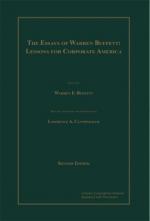
|
| Name: _________________________ | Period: ___________________ |
This test consists of 15 multiple choice questions and 5 short answer questions.
Multiple Choice Questions
1. How much profit did the new holding of Berkshire make for Buffett and Munger?
(a) $250M.
(b) $100M.
(c) $150M.
(d) $500M.
2. The bonds that Buffett decides to buy in 1989 were thought to be ________, but turn out to be fallen angels.
(a) Priceless.
(b) Junk.
(c) Meaningless.
(d) Evil.
3. What was the name of Warren Buffett's partner in the company they shared?
(a) Steve Jobs.
(b) Bill Gates.
(c) Lloyd Munger.
(d) Charlie Munger.
4. Preferred firms must pay returns above ______ investments and be compatible with management.
(a) Future.
(b) Mr. Market.
(c) Past.
(d) Fixed-income.
5. Berkshire's board included a controlling ________, in which other board members could persuade others to make changes.
(a) Shareholder.
(b) Outsider.
(c) Owner.
(d) Competitor.
6. Buffett dismissed risk in his choices with his notion that falling __________ prices present an opportunity to buy.
(a) Mortgage.
(b) Stock.
(c) Bond.
(d) Checking.
7. The current value of the company Buffett and his partner bought showed that they understated its current ________ value.
(a) Market.
(b) Intrinsic.
(c) Business.
(d) World.
8. What was coined as the term for the amount of undiscovered embezzlement?
(a) Bonding.
(b) Embezzling.
(c) Bezzle.
(d) Bezz.
9. Confusing ________ requirements were offset by the partners' willingness to report look-through earnings.
(a) Market.
(b) Accounting.
(c) Stock.
(d) Tax.
10. A CEO unlikely to dispose of his successful operating business may sell profitable stock investments to redeploy _________.
(a) Dividends.
(b) Capital.
(c) Nothing.
(d) Interest.
11. What was the name of the bond holdings that Buffett added to Berkshire in 1989?
(a) Pepsi.
(b) Arrowhead.
(c) RJR Nabisco.
(d) General Mills.
12. Buffett and Munger invested based on company operating results and not on ____________.
(a) Shareholder opinion.
(b) Profit margins.
(c) Price quotes.
(d) The stock market.
13. Munger and Buffett act like ________ when it comes to considering the economic prospects of the businesses they buy.
(a) Kids.
(b) Stock traders.
(c) Bankers.
(d) Business analysts.
14. Buffett and Munger both opposed any selective ________ and predictive growth rates from the CEOs who reported them.
(a) Disclosure.
(b) Strategies.
(c) Truth.
(d) Purchases.
15. What was the name of the company that Buffett and Munger bought in 1973?
(a) Florida Gazette.
(b) New York Times.
(c) Chicago Tribune.
(d) Washington Post.
Short Answer Questions
1. Buffett and Munger also followed the idea of minimal use of _______ and leverage, helping to create solid investments.
2. Buffett and Munger do not check _________'s manic depressive daily price quotes to validate their investment.
3. What was the title of Buffett's partner in the company they shared?
4. Berkshire was a ________ corporation, as it was described in this section of the book.
5. Buffett and Munger bought _________ companies the same way they might buy private companies.
|
This section contains 402 words (approx. 2 pages at 300 words per page) |

|




